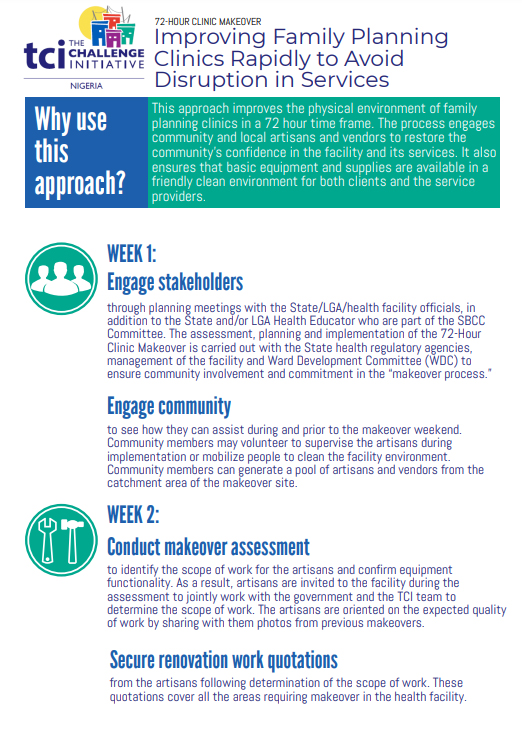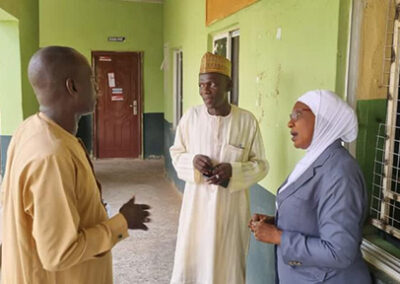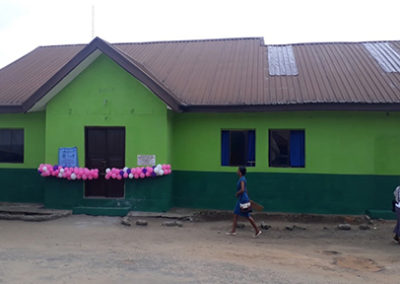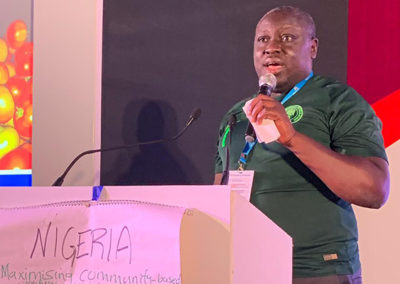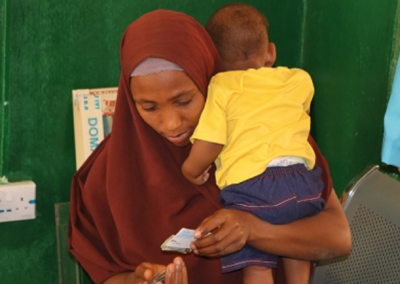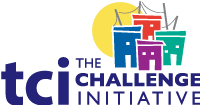Nigeria Toolkit: Services & Supply
- Home
- Help and Support
- Close
- Toolkits
- Global Toolkit
- AYSRH Toolkit
- Hub Toolkits
- Core High-Impact Practices
- Gender Essentials Mini Course
- Close
- Resource Collection
- Community of Practice
- Coaching
- Log In/Register
- My Profile
- English
72-Hour Clinic Makeover
What is it?
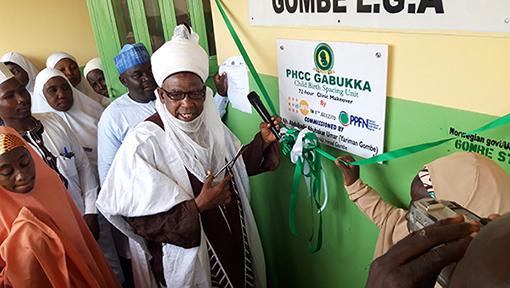 To make family planning services more inviting for clients and address the dilapidated infrastructure and state of disrepair of the facilities that the PIA revealed, TCI helps States to improve quality FP services without disrupting normal daily services by implementing the cost-effective 72-Hour Clinic Makeover approach. Cost-effectiveness is ensured through direct labor, which brings about community involvement.
To make family planning services more inviting for clients and address the dilapidated infrastructure and state of disrepair of the facilities that the PIA revealed, TCI helps States to improve quality FP services without disrupting normal daily services by implementing the cost-effective 72-Hour Clinic Makeover approach. Cost-effectiveness is ensured through direct labor, which brings about community involvement.
The 72-Hour Clinic Makeover approach is not a capital investment; it’s a top-up, improving the physical environment of clinics or other facilities that provide family planning services based on priorities identified as part of a makeover assessment. During the makeover, facilities are renovated, refurbished and equipped for optimal family planning service provision. By engaging the community and local artisans and vendors throughout the makeover process, the facility makeover also becomes a mental makeover restoring the community’s confidence in the facility and its services.
The 72-Hour Clinic Makeover is the culminating event after providers have been trained or retrained and provided materials for referrals, job aids, SOPs, IEC, etc. and communities have been mobilized.
Why is it important?
- Renovating facilities that are in disrepair or poorly equipped encourages clients to seek family planning (FP) services at the facilities
- Ensuring basic equipment and supplies and creating a friendly, clean environment enables providers to work properly
- Seeing a dramatic change in a short time creates excitement among the community and inspires clients to seek services. In addition, due to the community involvement throughout the process, the facility makeover enshrines a sense of community pride and ownership
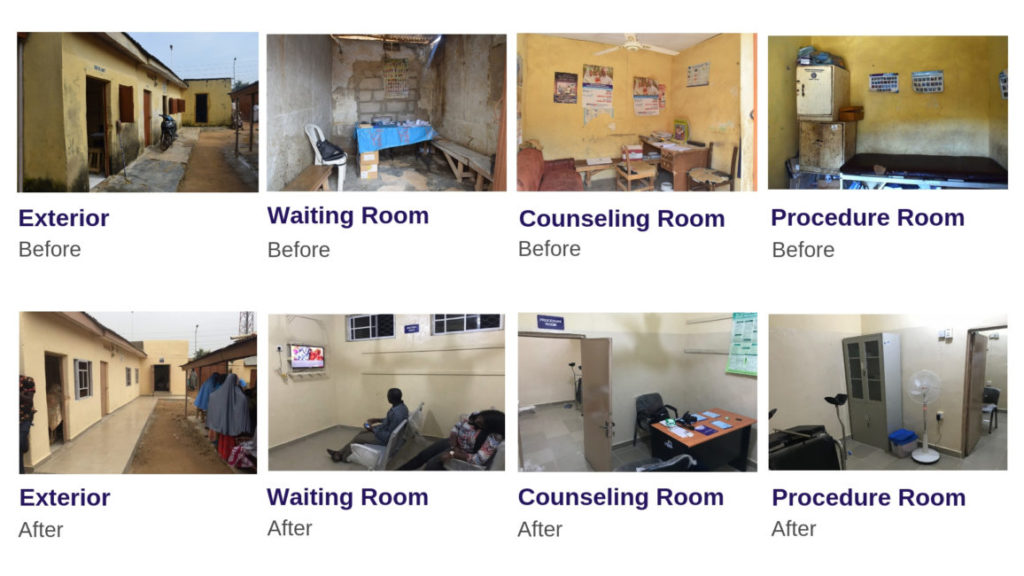
What are the steps for implementing this approach?
Week 1: Engage Stakeholders & Community Members
Stakeholder Engagement
In preparation for the 72-Hour Clinic Makeover, planning meetings are held with the State/LGA/Health Facility(ies) officials. It is also important that the State and/or LGA Health Educator/Social Mobilization Officer (SMO) who are part of the SBCC Committee participate in the planning meetings. The LGA Health Educator/SMO is responsible to provide details about the social mobilization component of the Makeover as well its implications for the SBCC Committee.
The assessment, planning and implementation of the 72-Hour Clinic Makeover is carried out with the State health regulatory agencies, management of the facility and Ward Development Committee (WDC) to ensure community involvement and commitment in the “makeover process”.
Community Engagement and Identify Artisans & Vendors
Concurrently, engage with the community to see how they can assist during and prior to the makeover weekend. For example, community members may volunteer to supervise the artisans during implementation or mobilize people to clean the facility environment.
In addition, community members, particularly through the QIT team, are met to generate a pool of artisan and vendors from the catchment area of the makeover site.
Week 2: Conduct Makeover Assessment, Secure Renovation Work Quotations and Develop SOW & Budget
Conduct MO Assessment
Although sites were selected during the PIA process, a second-level makeover (MO) assessment is conducted to identify the scope of work for the artisans and confirm equipment functionality status as earlier identified on the PIA tool. As a result, the artisans are invited to the facility during the MO assessment to jointly work with the government and TCI team to determine SOW for different work areas needed.
Whenever possible, use existing meetings with the Health Management Team and the Quality Improvement Team (QIT), if it is already established, as well as Health Management Information System (HMIS) and Reproductive Health/Family Planning (RH/FP) officers to debrief them on and engage them in the assessment process to avoid incorrect assumptions about the state of the family planning facility.
The MO assessment is conducted in a day to identify items needing repair and supplies needing replacement. With health facility staff, prepare a prioritized list of renovations, repairs and improvements for each facility. Where possible, use Open Data Kit (ODK) – an open source software – to record and share the findings.
Renovation work quotations
The renovation work quotations are submitted by the artisans following determination of the scope of work. These quotations cover all areas requiring makeover in the health facility.
Develop scope of work (SOW) and budget with artisans
Based on the findings from the MO assessment, prepare an action plan and timeline for each facility makeover (i.e., batching the facilities for makeover). Work with the artisans to get quotations based on the SOW determined from the MO assessment findings. The quotations received are used as a guide in developing the budget. In addition to the renovation costs, make sure to budget social mobilization activities and secure approval for the makeover budget; see the Guide to Social Mobilization for 72-Hour Clinic Makeover for more details.
A detailed checklist can facilitate coordination of the process, organization of tasks including the commissioning or opening event and assembly of all materials required.
Week 3: Procure Equipment & Furniture
Equipment and furniture purchase and transport
Communicate in advance when you expect the vendors to deliver the equipment and furniture needed for the makeover. Determine where, when and to whom the deliveries should be made. Branding arrangements should be made at this point as well.
Week 4: Implement, Mobilize the Community & Reveal the Makeover
Implement Facility Makeover
To avoid interrupting weekday services, repairs and renovations are carried out throughout the weekend, beginning at the clinic’s close of business on a Friday. By Monday morning, the clinic reopens in a renewed state, ready to provide optimal family planning services.
Mobilize the Community
A key component of the 72-Hour Makeover is Social Mobilization. The Social Mobilization during 72-Hour Clinic Makeover is aimed at creating awareness about the Makeover in communities around the designated health facilities, conducting sensitizations as well as referrals to the facilities where the Makeover is taking place. The social mobilization is conducted through a combination of the following activities:
- Neighborhood Campaigns which are carried out from door-to-door
- Sensitization exercises at Association meetings within the community
- Other community gatherings/events taking place around that period
Note: It is important to clarify the following information before heading into the community to start mobilization. This is to ensure that prospective clients have the information they need to receive a stress-free service.
-
Clinic opening hours
-
Any payment(s) to be made by prospective clients, the specific amount and reasons for the payment
-
Adequacy of staff in the FP clinic to cope with the expected rise in client flow particularly on the day of the commissioning
Reveal Makeover in Public Event
Hold a public commissioning when the makeover is complete to reveal the improvements; invite a prominent leader to officially reopen the facility. Use the opportunity to promote the services offered at the facility and encourage community leaders to show their support for family planning.
Results and Lessons Learned
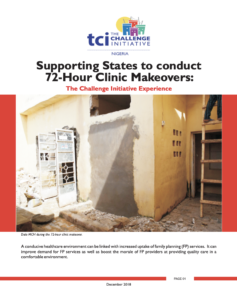 In line with TCI’s Business Unusual model of providing support to States to lead and implement high impact reproductive health interventions, the 72-Hour Clinic Makeover is spearheaded by the States with technical input and guidance from TCI. TCI’s three-pronged approach to program implementation – Advocacy, Demand Generation and Service Delivery – are all employed in executing the 72-Hour Clinic Makeover.
In line with TCI’s Business Unusual model of providing support to States to lead and implement high impact reproductive health interventions, the 72-Hour Clinic Makeover is spearheaded by the States with technical input and guidance from TCI. TCI’s three-pronged approach to program implementation – Advocacy, Demand Generation and Service Delivery – are all employed in executing the 72-Hour Clinic Makeover.
TCI employs but has adapted NURHI’s nine-step approach in order to allow State teams to spearhead the implementation of the 72-Hour Clinic Makeover. Learnings from TCI’s experience has led to the refinement of this process in which multiple steps can be carried out within each week. Following this process, 31 facilities have benefitted from the 72-Hour Clinic Makeover to date; there are plans to scale up this proven approach and process to 50 facilities in 10 states across Nigeria.
To learn more about our lessons learned, click on the image at the left.
TCI APP USERS PLEASE NOTE
You will only receive CERTIFICATES by email – when earning a score above 80% – and will not be able to view or print a certificate PDF from the TCI app.
Test Your Knowledge
Earn a Certificate
Quiz Summary
0 of 4 Questions completed
Questions:
Information
You have already completed the quiz before. Hence you can not start it again.
Quiz is loading…
You must sign in or sign up to start the quiz.
You must first complete the following:
Results
Results
0 of 4 Questions answered correctly
Your time:
Time has elapsed
You have reached 0 of 0 point(s), (0)
Earned Point(s): 0 of 0, (0)
0 Essay(s) Pending (Possible Point(s): 0)
Categories
- Not categorized 0%
- 1
- 2
- 3
- 4
- Current
- Review
- Answered
- Correct
- Incorrect
-
Question 1 of 4
1. Question
The makeover is the culminating event after providers have been trained, material referrals have been provided, and communities have been mobilized.
CorrectIncorrect -
Question 2 of 4
2. Question
The makeover is important because it:
CorrectIncorrect -
Question 3 of 4
3. Question
How useful did you find the information and/or tools presented on this page? Please write your response in the box below using one of the following phrases: Very useful, Useful, Somewhat useful, Not useful.
Feel free to comment on why you made that choice.
-
This response will be awarded full points automatically, but it can be reviewed and adjusted after submission.
Grading can be reviewed and adjusted.Grading can be reviewed and adjusted. -
-
Question 4 of 4
4. Question
How do you intend to use the information reviewed and/or tools that you accessed?
-
This response will be awarded full points automatically, but it can be reviewed and adjusted after submission.
Grading can be reviewed and adjusted.Grading can be reviewed and adjusted. -


